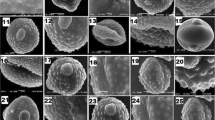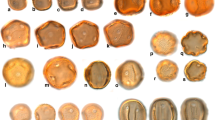Abstract
Pollen morphology of four Matricaria species and 28 Tripleurospermum species was investigated with light microscopies (LM) and scanning electron microscopies (SEM). Pollen slides were prepared using Wodehouse technique. Measurements were based on 20 or more pollen grains per specimen. For SEM studies, dried pollen grains were transferred on aluminum stubs and coated with gold for 4 min in a sputter-coater. The pollen grains of Matricaria and Tripleurospermum are radially symmetric and isopolar. The pollen grains of the Matricaria are oblate-spheroidal with the polar axes 16.6–31.2 μm and the equatorial axes 18.7–23.9 μm. Tripleurospermum is oblate-spheroidal, suboblate and prolate-spheroidal with the polar axes 15.6–32.2 μm and the equatorial axes 17.7-38.5 μm. The pollen grains of Tripleurospermum are operculate and tricolporate. Matricaria is operculate and usually tricolporate or rarely syncolporate, tricolpate and tetracolporate. The pollen grain of both taxa shows echinate ornamentation. The spines are commonly conical with a broadened base and a tapered apical portion. The spine length varies between 1.8–4 μm in Tripleurospermum and 2.3–3.3 μm in Matricaria. The width of spines varies between 2.8–4.6 μm in Tripleurospermum and 2.4–3.6 μm in Matricaria. Inter-spinal area shows granulate–perforate, reticulate–perforate, rugulate–perforate ornamentations and the tectum surrounding the spine base is micro perforate. Overall exine thickness ranges from 2.8 to 4.8 μm in Tripleurospermum, 3.6 to 5.2 μm in Matricaria. Intine is thicker under pores in Tripleurospermum (0.3–0.62 μm) than in Matricaria (0.6–0.8 μm). Inter-spinal ornamentations, pollen shape and the numbers of perforations at the spin base have been observed as important morphological characters.











Similar content being viewed by others
References
Altuner EM, Çeter T, Alpas H (2012) High hydrostatic pressure processing: a method having high success potential in pollen protein extraction. High Pres Res 32(2):291–298
Applequist WL (2002) A reassesment of the nomenclature of Matricaria L. and Tripleurospermum Sch. Bip. (Asteraceae). Taxon 51:757–761
Beug HJ (2004) Leitfaden der Pollenbestimmung für Mitteleuropa und angrenzende Gebiete. Verlag Dr. Friederich Pfeil, München
Blackmore S (1982) The apertures of Lactuceae (Compositae) pollen. Pollen Spores 24:453–462
Blackmore S (1990) Sporoderm homologies and morphogenesis in land plants, with a discussion of Echinops sphaerocephala (Compositae). Plant Syst Evol (Suppl 5):1–12
Bremer K, Humphries CJ (1993) Genetic monograph of the Asteraceae–Anthemideae. Bull Nat His Mus Lond (Bot) 23:71–177
Brochman C (1992) Pollen and seed morphology of Nordic Draba (Brassicacea): phylogenetic and ecological implications. Nord J Bot 12:657–673
Chatuverdi M, Yunus D, Nair PK (1990) Cytopalynological studies of Arachis L. (Leguminosae). Cultivated and wild species and their hybrids. Grana 29:109–117
Enayet Hossain ABM (1975) Tripleurospermum Schultz Bip. In: Davis PH (ed) Flora of turkey and the east aegean islands, vol 5. Edinburgh University Press, Edinburgh, pp 295–311
Erdtman G (1969) Handbook of palynology, morphology, taxonomy and ecology. Munksgaard, Copenhagen
Faegri K, Iversen J (1975) Textbook of pollen analysis, 4th edn. Wiley, New York
Gower JC (1971) A general coefficient of similarity and some of its properties. Biometrics 27:857–871
Grierson AJC (1975) Matricaria L. In: Davis PH (ed) Flora of turkey and the east aegean islands, vol 5. Edinburgh University Press, Edinburgh, pp 293–295
Hansen HV, Christensen KI (2009) The common chamomilla and the scentless mayweed revisited. Taxon 58(1):261–264
Harling G (1951) Embryological studies in the compositae, part II, Anthemideae–Chrysantheminae. Acta Horti Berg 16:1–56
Inceer H, Beyazoglu O (2004) Karyological studies in Tripleurospermum (Asteraceae, Anthemideae) from north-east Anatolia. Bot J Linn Soc 146(4):427–438
Inceer H, Hayirlioglu-Ayaz S (2008) Tripleurospermum ziganaense (Asteraceae, Anthemideae), a new species from north-east Anatolia, Turkey. Bot J Linn Soc 158:696–700
Inceer H, Hayirlioglu-Ayaz S (2010) Chromosome numbers in Tripleurospermum Sch. Bip. (Asteraceae) and closely related genera: relationships between ploidy level and stomatal length. Plant Syst Evol 285(3–4):149–157
Inceer H, Ozcan M (2011) Leaf anatomy as an additional taxonomy tool for 18 taxa of Matricaria L. and Tripleurospermum Sch. Bip. (Anthemideae–Asteraceae) in Turkey. Plant Syst Evol 296(3–4):205–215
Inceer H, Bal M, Ceter T, Pinar NM (2012) Fruit structure of 12 Turkish endemic Tripleurospermum Sch. Bip. (Asteraceae) taxa and its taxonomic implications. Plant Syst Evol 298:845–855
İnceoğlu O (1973) Asyneuma canescens (W.K.) Griseb. & Schenk’in polen morfolojisi ve heteremof polenler. Türk Biyoloji Derg 23:89–94
Inceoğlu Ö, Karamustafa F (1977) The pollen morphology of plant in Ankara region I. Compositae. Communications 21:77–100
Jeffrey C (1979) Note on the lectotypification of the names Cacalia L. Matricaria and Gnaphalium L. Taxon 28:349–351
Kay QON (1976) Chamomilla S.F.Gray and Matricaria L. In: Tutin TG, Heywood VH, Burges NA, Moore DM, Valentine DH, Walters SM, Webb DA (eds) Flora Europaea, vol 4. Camridge University Press, Camridge, pp 165–167
Kerguélen M, Bosc C, Lambinon J (1987) Données taxonomiques nomenclaturales et chrologiques pour une révision de la flore de France. Lejeunia 120:1–264
McNeill J (1979) Structural value: a concept used in the construction of taxonomic classifications. Taxon 28:481–504
Mesfin T, Crawford DJ, Smith EB (1995) Pollen morphology of North Coreopsis (Compositae). Grana 34:21–27
Mohammadi SA, Prasanna BM (2003) Analysis of genetic diversity in crop plants. Salient statistical tools and considerations. Crop Sci 43:1235–1248
Nair PK, Kaul KN (1965) Pollen grain in a gigantic of Rauwolfia serpentine. Current Sci 34:256–257
Oberprieler C (2001) Phylogenetic relationships in Anthemis L. (Compositae, Anthemideae) based on nrDNA ITS sequence variation. Taxon 50:745–762
Oberprieler C, Vogt R and Watson LE (2007) XVI. Tribe Anthemidea Cass. In: Kadereit JW, Jeffrey C, Kubitzki K (eds) Flowering plants Eudicots. The families and genera of vascular plants 1819, vol 8. Springer, Berlin, pp 342–374
Pınar NM, Adıgüzel N (1998) Pollen morphology of some Turkish Artemisia L. (Compositae) species. Ot Sistematik Botanik Dergisi 5(2):87–92
Pınar NM, İnceoğlu Ö (1996) A Comparative study on the pollen morphology of Centaurea triumfettii All. groups A, B and C with light and electron microscopy. Turk J Bot 20:395–398
Pınar NM, Oybak Dönmez E (2000) Pollen morphology of some Turkish endemic Helichrysum Gaertner species (Compositae). Pakistan J Bot 32(2):295–301
Pınar NM, Ekici M, Aytac Z, Akan H, Ceter T, Alan Ş (2009a) Pollen morphology of Astragalus L. sect. Onobrychoidei DC. (Fabaceae) in Turkey. Turk J Bot 33:291–303
Pınar NM, Duran A, Çeter T, Tuğ GN (2009b) Pollen and Seed Morphology of the Genus Hesperis L. (Brassicaceae) in Turkey. Turk J Bot 33(2):83–96
Podani J (1999) Extending Gower’s coefficient of similarity to ordinal characters. Taxon 48:331–340
Podani J (2001) SYN-TAX 2000. Computer programs for data analysis in ecology and systematics. User’s manual. Scientia, Budapest, Hungery, pp 1–53
Punt W, Hoen PP (2009) The Northwest European Pollen Flora, 70: Asteraceae–Asteroideae. Rev Palaeobot and Palynol 157:22–183
Rauschert S (1974) Nomenklatorische probleme in den gatung Matricaria L. Folia Geobot Phytotax 9:249–260
Salgado-Labourıau ML (1982) On cavities in spines of Compositae pollen. Grana 21:97–102
Skvarla JJ, Larson DA (1965) An electron microscopic study of pollen morphology in the Compositae with special referencemto the Ambrosiinae. Grana Palynol 6(2):210–269
Sokal RR, Rohlf FJ (1962) The comparison of dendrograms by objective methods. Taxon 11:33–40
Stix E (1960) Pollenmorphologische Untersuchungen an Compositen. Grana Palynol 2(2):41–114
Van der Pluym A, Hideux M (1997) Applications d’une methodologie quantitative a la palynologie d’Eryngium maritimum (Umbelliferae). Plant Syst Evol 127:55–85
Wagenitz G (1955) Pollenmorphologie und Systematik in der Gattung Centaurea L. s.l. Flora 142:213–277
Ward JM (1993) Systematics of New Zealand Inuleae (Compositae–Asteraceae)-2, A numerical phenetic study of Raoulia in relation to allied genera. New Zeal J Bot 31:29–42
Watanabe W (2009) Index to chromosome numbers in Asteraceae. http://www.lib.kobe-u.ac.jp/infolib/meta_pub/G0000003asteraceae_e, updated September 2009, Accessed 17 July 2012
Wodehouse PP (1935) Pollen grains. McGraw-Hill, New York
Xifreda CC (1985) Sonre el nombre cientifica correcta de la manzanilla (Matricaria recutita L., Asteraceae). Darwiniana 26:373–375
Acknowledgments
The authors thank Scientific and Technological Research Council of Turkey (TUBITAK, TBAG Project No. 106T162) for financial support.
Author information
Authors and Affiliations
Corresponding author
Rights and permissions
About this article
Cite this article
Çeter, T., Pinar, N.M., İnceer, H. et al. The comparative pollen morphology of genera Matricaria L. and Tripleurospemum Sch. Bip. (Asteraceae) in Turkey. Plant Syst Evol 299, 959–977 (2013). https://doi.org/10.1007/s00606-013-0776-z
Received:
Accepted:
Published:
Issue Date:
DOI: https://doi.org/10.1007/s00606-013-0776-z




